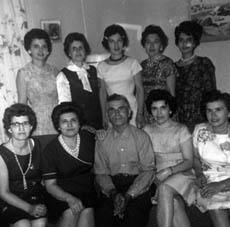

Leclerc dit Lafleur
Jean Leclerc, with his wife, Marie Blanquet, and their son, Pierre, left Dieppe, Normandy, France during the 1659 navigational season to take their chances in New France. Marie's father, Adrien Blanquet, was already in the country since 1658, a farmer in the sub-seigneury of the Beaulieu stronghold on l'Île de Orléans (parish of Sainte-Pétronile) and in addition to being a widower, he was given addition concessions of property. He sorely needed someone to assist him with the workload and the possible opportunities. All indications are that Jean and his family were very welcomed at his father-in-law's.
It was on August 10, 1662, that Jean officially received his first concession of property in the stronghold of La Chevalerie (parish of Saint-Pierre), a neighbouring stronghold to Beaulieu. Exceptionally, Jean received four arpents of frontage, instead of the two arpents that the others received that same day. The depth of this concession went to an imaginary line that separated the island in two along its width, about 33 arpents deep, for a total acreage of 132 arpents.
On August 18, 1678, the declaration and numbering of the seigneury of La Chevalerie indicated that Jean Leclerc, owning lots 61, 62 and 63 had eight arpents of frontage. It was not a gift. The exchange of lands with Jacques Bernier dit Jean de Paris, his neighbour, was an act of faith. Jean Leclerc offered to clear ten arpents of Bernier's property located at Cap-Saint-Ignace, on the opposite side of the river. With the wood he would construct a house of twenty-five feet in length as well as a barn forty feet in length, along side of a creek on the cape. This was beyond comprehension. How was he able to complete this task while maintaining his own property and all the tasks necessary on a farm?
In the documetation of that time, it is noted that there was a very strong demand for land. No doubt, it was his intention to set up his four sons Pierre, Adrien, Jean-Charles and Martin on the properties. Historians mentionned that for a while, along with Gabriel Gosselin, he was the largest land-owner on Île d'Orléans.
On February 25, 1680, before the notary Paul Vachon, according to the marriage contract of his daughter, Anne, with Jacques Bouffard, it stated that Jean Leclerc was a master boot maker and "at present, absent in France". He never returned.
On the 1681 Census, Marie Blanquet is noted as a widow. She was then fifty years of age. She was the mother of ten children, of which three died as infants, three daughters who married other pioneers, a son, Martin, who died at the age of twenty nine years, and was buried in Saint-Pierre's Church to honour his contribution to the parish. The other three sons, names above, perpetuated the Leclerc surname over the years and around the world. This line of Leclerc is, by far, the most numerous.
Marie Blanquet survived Jean Leclerc for another twenty-nine years. On her tombstone it states she was 86 years of age, but in fact she was only 78 years old. She was buried on September 11, 1709 in Saint-Pierre's Church, like her son, Martin, was on March 8, 1703. She is beside the choir area, just below the holy water font. On October 12, 1718 her remains, as well as those of her son, were transferred to the new Saint-Pierre Church. The historian, Pierre-Georges Roy, states "that she was a knowledgeable business woman, and an exemplar Christian with heart felt qualities, or a large soul".
The author, Gilles P. (#037), a descendant of this ancestor, had to reduce his 56 page account to one page and could do no better. For more information, please contact him, and you will find it his favourite subject. As of this date, of this ancestry, we have numerous members who descend from his sons: Pierre (144), Adrien (127) and Jean-Charles (20) for a grand total of 291 members who owe their existence to Jean Leclerc and Marie Blanquet. We acknowledge all of them.
Writer Gilles P. Leclaire